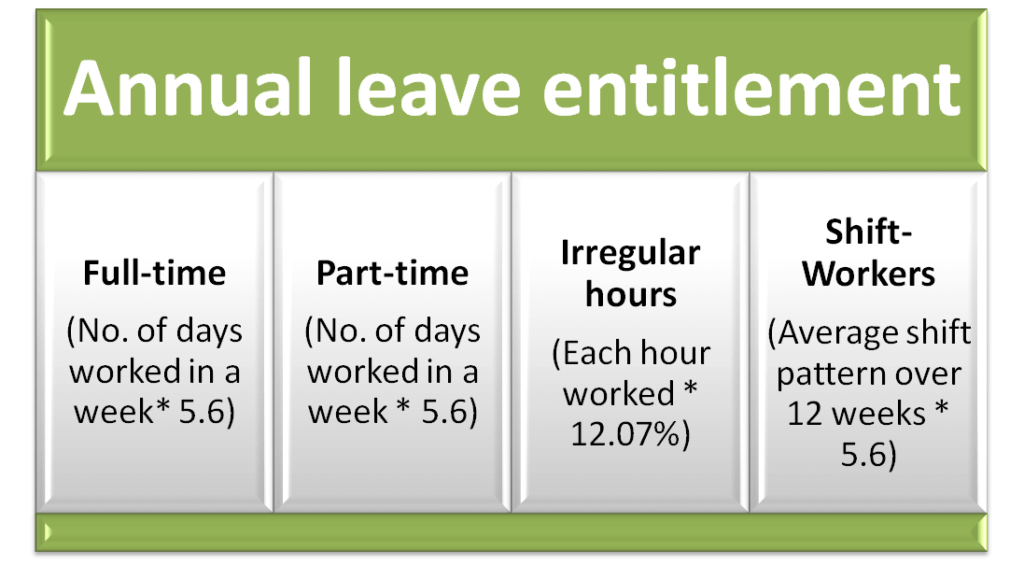No matter how much an employee enjoys their work, long extended holidays are essential to recharge.
Apart from statutory requirements, employers must realise that having a good holiday allowance for every worker makes them feel valued and boosts their performance.
It may be tricky to calculate the annual leave entitlement, but it is necessary for every business with employees.
Here, we will find some easy ways to calculate annual leave for full-time, part-time and irregular working time employees.
This guide will cover the following:
Table of Content
- What is annual leave?
- Can we carry over the entitled annual leave?
- Does Annual leave entitlement include bank or public holidays?
- Can a company offer more annual leave days than the minimum entitlement?
- Why does annual leave entitlement vary?
- How to calculate an annual leave?
- How are payments made for annual leave?
- How to create an annual leave policy in an organisation?
- How to book holidays?
- Wrapping Up
What is annual leave?
Annual leave is paid time off for employees in an organisation. A worker can take a certain number of leaves while their payments remain the same as working days.
Annual leave doesn’t affect your regular wage. It is an employee’s right that starts from the first day of a job. Employers can use a yearly leave calculator to check the timely payments.
Full-time workers are legally entitled to at least 28 days or 5.6 weeks of annual leave. An employer must have a leave policy of annual leave. Employers use a ‘leave year’ or an ‘accrual’ system to determine how much leave they can approve for each employee.
Can we carry over the entitled annual leave?
Workers need to use their entitlement in a year, and companies must pay attention to such thoughts to avoid financial penalties.
Legally, one can carry the entitled annual leave over to 4 weeks for the next two leave years. An employee can carry over the remaining 1.6 weeks or any additional leave from the company at their discretion.
However, there must be a valid reason to carry over the annual leave on both employee and employer sides.
Here are a few factors that may lead to employers disapprove of holidays:
- The company had a significant increase in demand and required workers to meet the needs.
- Disruption in the business workforce due to a significant cause like a coronavirus pandemic can make employers reject leave.
- There can be an important social impact if workers take an immediate leave.
- The available workforce is not sufficient for the company.
Does Annual leave entitlement include bank or public holidays?
Employers can or cannot include bank or public holidays in your annual leave entitlement. It would be best to have a clear conversation with the employer regarding annual leaves before working in the organisation.
For example, there are eight bank holidays in the UK; if the employer includes them with the 28 days of holiday entitlement, your annual leave reduces to 20 days.
Can a company offer more annual leave days than the minimum entitlement?
Yes, a company can offer employees more holidays than the minimum annual leave entitlement. Employees have the legal right to have a minimum of 28 days of paid holiday. However, there is no upper limit for annual leave days.
As an employer, make sure you can afford a generous annual leave package. Some companies may find holidays increase productivity, while others suffer from excessive burden and anxiety.
Why does annual leave entitlement vary?
The annual leave entitlement varies with:
- The type of worker
- Number of days or hours of work
- Additional contract with the employer
Full-time employees receive more annual leave than part-time employees or casual workers. They work for more days and hours in comparison to other categories.
| Type of Worker | Working hours | Annual leave |
| Full-time workers | >35 hours per week | 28 days annual leave |
| Part-time workers | < 35 hours per week | Pro-rata proportion of 5.6 weeks |
| Irregular hours | 10 hours a week | 10 × 12.07% = 1.307 hours |
How to calculate an annual leave?
The annual leave starts as soon as an employee begins working. Let us see how to calculate annual leave for employees working full-time, part-time, or irregular hours.
Full-time employees
These individuals need to multiply the number of days they work in a week and 5.6 (minimum annual leave 5.6 weeks per year).
Suppose you work five days a week,
Your annual leave is 5 × 5.6 = 28 days in a year.
But, if you work for six days a week, your annual leave is 6 × 5.6 = 33.6 days. However, according to law, you will receive only 28 days of paid holidays.
Part-time employees
These individuals can find their annual leave entitlement by multiplying the number of days working in a week and 5.6.
Suppose you work for two days a week,
So your annual leave will be 2 × 5.6 = 11.2 days. You can take 11 full days’ leave. But,
What about that 0.2 days?
In such cases, you can talk with the employer. Employers cannot round them to full holidays for part holidays but can allow you to take an early leave or come in late to work.
Working irregular hours
You multiply the number of hours worked in a week by 12.07% [5.6 / ( 52 weeks of a year – 5.6 weeks = 46.4) × 100].
For example, if you work 12 hours a week,
Your annual leave entitlement is 12 × 12.07% = 1.45 hours.
Working on shifts
If you work in shifts, take the average pattern over 12 weeks and multiply it by 5.6.
Suppose you want to calculate the annual holiday for shifts you need,
- How many hours are in each shift? – 12 hours
- How many shifts will you work in each shift pattern? – 4
- How many days are in the shift pattern? – 4
The annual leave entitlement is 28 shifts per year, and every shift is 12-hours.

How are payments made for annual leave?
The payments made during annual leave are the same as that of the employee’s standard wage.
For example,
If an employee earns £800 ( £20 an hour for 4 days of 10 hours) and takes 3 days of annual leave;
So, their gross salary before income tax and NI during this period is £600 (£20 an hour for 3 days of 10 hours).
It is easy to calculate your annual leave when the employer sets a contract with you. But, it becomes difficult, when
· Employees don’t have a fixed working hour
We can calculate the payments considering the average working hours or shifts at an average hourly rate for the last 12 weeks.
· Employees working on casual hours
We need to consider the average payments for the last 13 weeks to understand the annual leave pay.
How to create an annual leave policy in an organisation?
An annual leave policy for any organisation is necessary to keep away misunderstandings between employers and employees. A well-written policy will ensure the position and entitlements of an employee. An annual leave policy must contain the following:
Details on entitlement
An employee must know their legal rights for annual leave. The policy should mention the employee’s annual leave days in a year and include bank holidays.
Starting date of the holiday year
A contract must include the starting date of a holiday year. Generally, it is the first day of your job, 1st January, or the financial year. When employees know the leave year, they can book holidays to make good use of the entitlement.
How to book holidays?
Every organisation has specific holiday booking rules and regulations. Therefore, an employee must mention them in the policy to understand how to request holidays. Generally, you can use the company HR system to ask for a leave.
Limitations
Employers must point out annual leave limitations, including when to take holidays.
Legally, a full-time employee can get 28 days of annual leave for working 5 days a week. Even if they work for 6 days, employers cannot extend the annual leave period.
Annual leave grants
Specific periods of the year are famous for employee leaves. An organisation needs to set a good policy to keep a few employees working while others are on leave.
For example, your company gets maximum leave requests during Summer and Christmas. You can ask employees which one they prefer. If an employee takes a leave for summer, they must be available during Christmas.
Notice period
Employers must inform about the notice period of leave in the policy.
If an employee wants a holiday for a week, they must inform the employer 1 week before the date of leave.
Ensure that you include a term in the policy that HR can reject a holiday request without prior notice.
Rules for carrying over leave
There are a few legal conditions to carry over your annual leave. An employer must mention these legal conditions in the policy.
A policy should contain the maximum number of days to be carried over, the deadline to use the carried over leave, and in what event you can carry an annual leave.
Employer’s right to refuse or cancel leave
Employers cannot refuse a pre-approval letter or a holiday request to maintain employee values and business structure. However, they can ask you to take a leave some other time in a busy schedule.
Calculation of leave
We have discussed how to calculate leave at the beginning of the guide. One more point to add, employees who are leaving the company can earn more for the unused leave. Also, if they can use more holidays than the entitlement, the company can deduct money from the final salary.
Wrapping up
Workers must enjoy holidays to make productive outcomes in any company. Employers need to encourage them to take leave.
The annual leave policy can be complicated, but individuals must clearly understand what the employer is offering. Similarly, employers need to skillfully draft an excellent yearly leave policy to attract employees and work efficiently for the company.
Holidays are necessary for workers to relax from busy schedules and return to work with bigger mindsets and aspirations.










Leave a Reply